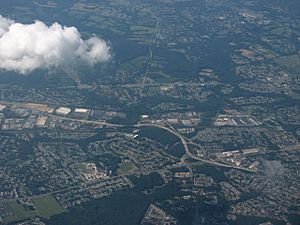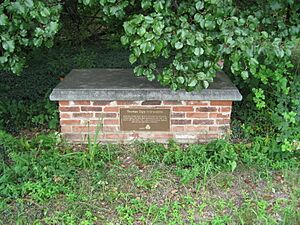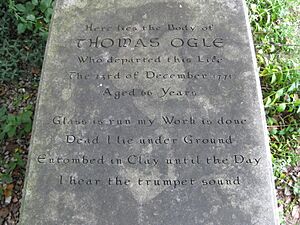Ogletown, Delaware facts for kids
Quick facts for kids
Ogletown, Delaware
|
|
|---|---|

Aerial view of Ogletown
|
|
| Country | United States |
| State | Delaware |
| County | New Castle |
| Elevation | 79 ft (24 m) |
| Time zone | UTC-5 (Eastern (EST)) |
| • Summer (DST) | UTC-4 (EDT) |
| Area code(s) | 302 |
| GNIS feature ID | 214405 |
Ogletown is a small, unincorporated community in New Castle County, Delaware, United States. It is located where Delaware routes 4 and 273 meet. This spot is about three miles east of Newark.
Many people say that Maryland Bank (MBNA) "ate Ogletown." This is because the State of Delaware offered MBNA special financial help to move there. By the late 1980s, MBNA bought and removed most of Ogletown's historic buildings and businesses. However, MBNA also created many jobs for people living in the area. It played a big part in Ogletown's growth into a suburban community.
The History of Ogletown
The story of Ogletown begins with John Ogle. He came from England in 1664 as a soldier. His son, Thomas Ogle (born between 1666 and 1672, died 1734), became an early landowner in what is now central New Castle County, Delaware.
Ogletown gets its name from Thomas Ogle's son, Thomas Ogle II (born around 1705, died 1771). He settled in the area of today's Delaware Route 273 and Delaware Route 4 in the 1730s. Thomas Ogle II's burial site is now surrounded by a highway cloverleaf. There is an effort to recognize him and improve the area around his grave.
The name "Ogletown" was used for the area before 1774. In the late 1800s, it was a small village. It had a store, a post office, and about six houses. More homes and businesses appeared throughout the 1900s.
Ogletown eventually lost its village feel. This happened because of suburban growth, changes to roads, and the arrival of Maryland National Bank (MBNA). New main highways were also built.
- Ogletown grew well in the 1600s. It was located along an important road that crossed the peninsula. This road went from the Head of Elk on the Chesapeake Bay to Christiana Bridge. The way the roads curved in Ogletown made it a good place for a small community. It even had an inn for travelers.
- From 1994 to 1999, a project to expand Route 273 removed any remaining parts of the original village. During this highway construction, the grave of Thomas Ogle II was found. It had been "badly disturbed" by road work and a gas station built on the site.
- As part of the project, the Delaware Department of Transportation (DelDOT) restored the brick base and capstone of the grave. The Ogle Family Association helped pay for this. Thomas's remains were not moved. The grave is now in a green space inside the new highway intersection. Only a small plaque on the brick base tells the town's history.
- In 2016, a group called Save the Orphanage Property (STOP) started a campaign. They wanted to protect Ogletown's last open space. This land was suitable for a large park. The Felician Sisters of North America owned the land. The effort to save the land for a park was not successful in 2018.
- In 2021, a group called Ogletown Resilience applied for a historical marker. They submitted the application to the Delaware Public Archives. This was part of an effort to recognize Ogletown. Thomas Ogle, the town's founder, died 250 years ago in 1771. The approval for this marker was announced on March 10, 2022.
Today, people and businesses in the area use Newark postal addresses. The name Ogletown mostly survives in the names of Ogletown Road and Ogletown-Stanton Road.
Remembering Ogletown's Founder
Thomas Ogle's restored gravesite remembers the Ogletown area and the Ogle family's importance. However, it is not well-kept. It does not clearly show its history or welcome visitors.
Groups like Ogletown Resilience and the Delaware Public Archives began an effort to recognize Ogletown. This was important because it was 250 years since Thomas Ogle's death in 1771. They asked for a historical marker to be placed at the gravesite. This request was approved on March 10, 2022.
These groups are also asking for new pathways that meet American Disabilities Act (ADA) rules. They want parking near Ogletown Baptist Church. They also hope for signs that share history and help people find their way. These pathways are required by federal law to be accessible for everyone.
The DelDOT has usually not allowed car access or parking at Thomas Ogle's gravesite. This is due to highway speeds and safety concerns. However, the East Coast Greenway (ECG) is a walking and biking path nearby. It passes within 50 yards of the grave, but it is not well-maintained.
Along with the historical marker request, people have asked for the ECG and two other local paths to be repaved. They want them connected according to Delaware's road guidelines. This also includes changing the ECG to connect directly to the gravesite and its amenities.
One idea for this project is "Ogletown Greenway." It would be about half a mile long. A first meeting was held on December 10, 2021. It included supporters, Delaware's Marker Program Coordinator, and two State Legislators. Everyone was very supportive. More meetings have happened to build support. Delaware Greenways has promised to support an Ogletown Greenway. They will include it in their project list.
As of February 17, 2024, the historical marker has not been put in place. Also, no clear progress has been made on the new pathways.





